
I’m skeptical about writer’s “aids.” Prompts, nudges and cures for writer’s block abound, but where do they lead? How many published novels came to print after using a prompt in the book? If a tree falls in the forest, will anyone read your prompt-inspired manuscript?
So when Write Starts: Prompts, Quote and Exercises to Jumpstart Your Creativity crossed my desk, I approached with trepidation. Although I am indeed a vocal advocate of Julia Cameron’s The Artist’s Way, I remain somewhat close-minded about other systems established to motivate creativity. Perhaps I saw too many of them warped, or something about it seemed too artificial. Perhaps my inner critic does too good a job warding off methods that lead to different avenues for me – after all, that critic does keep out some bad ideas, too.
The only way to test tools such as this book is to use it. I chose, for purposes of FacingNorth.net, the chapter “Magical Thinking: it’s all in the cards.” This deviates from much of the book that relies on memory and sensory experience to write, and invites the writer to use a few approaches to tarot card reading as a way of overcoming the blocks and puzzles that arise while writing your way through a story. For my own test, I used the simple reading of three cards: Root, Gain and Solution.
Using the Salvador Dali tarot (because it sits by my desk where I write) I pulled the following cards:
- Root: 9 of Swords, inverted (a character on a bed, with lots of swords sticking around. I read this as a sort of stuckness/suffering without full awareness of suffering, since it’s inverted.)
- Gain: 8 of Pentacles (a person in a garden, receiving care and bounty, seemingly from multiple sources.)
- Solution: 9 of Pentacles, inverted (a person whose isolation becomes his impoverishment when intended as enrichment.)
While I can easily equate this reading with my personal life, for purposes of fiction, I can create the following story:
Lorelei sleepwalked through life. Certainly she had moments where she fought to wake up, to pull herself away from the chemicals coursing through her veins, their narcotic influence ever dragging her back to the numbness in which she languished. So when her sister’s lottery winnings allowed her to check into rehab, she felt happy for the comfort and for relief from her past debts, but doubtful that it would take. But then there was the day that the caretaker’s dog came yipping up to her, and she felt awake, and bright, and connected. Her mother came, then her sister. She received a note from her father, and she returned to the family fold and the family business, making the chain of tea shops miniature gourmet sensations throughout mid-populated towns in the Midwest.
That was four years ago. Now, relatively clean of her old addictions, she had everything she needed, but unlike her old somnolence, she was achingly aware of her disconnection from the easy-breathing world.
It’s definitely an interesting technique, a good place for a powerful imagination to rebound off of. I have seen workshops for writers involving tarot in my own community; I suspect that many of the ideas work like the one presented in this book.
All of the exercises in this book lean towards the single achievement of authenticity. Nothing frightens a writer more, and few things can make a written work better than the jugular-exposing experience of another person’s truest self-revelation. But even though writing at beginning and end is a solitary pursuit, finding the will to reveal so truly takes help from friends along the way. This book is definitely one way to get to that level of revelation, exposed, vulnerable and offering up some of your best stuff.
If you know a stuck writer or happen to be one, this book merits a try. After all, in the worst case scenario, you might actually write something.
~ review by Diana Rajchel
Author: Hal Zina Bennett
New World Library, 2010
pp. 176, $14.00
